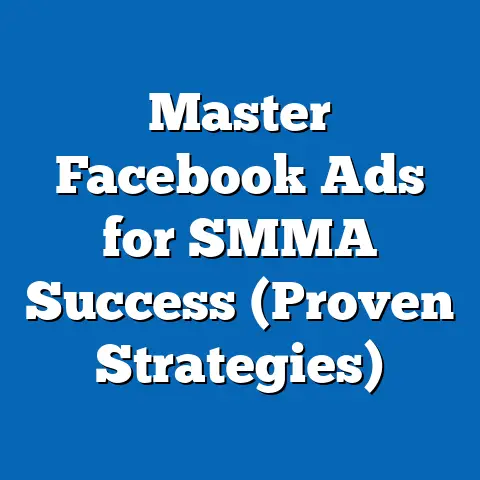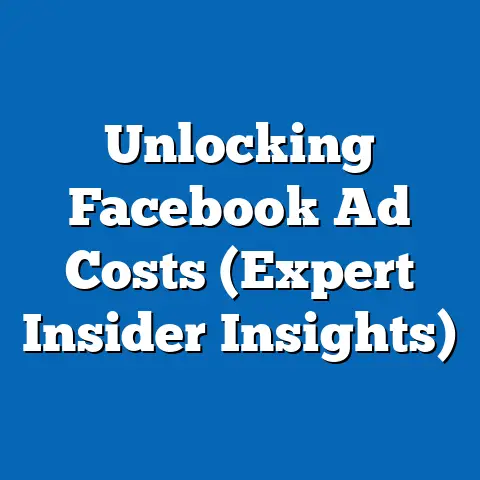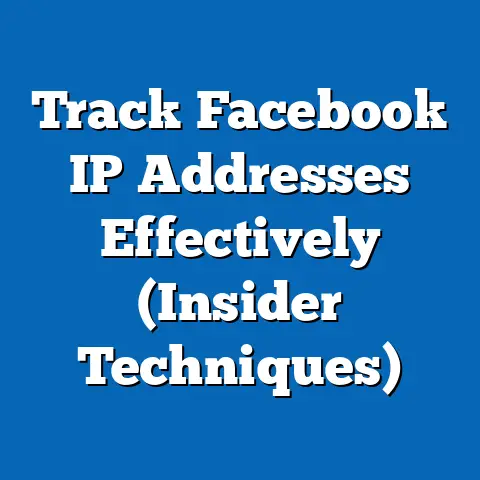Mastering Analytics: Google vs. Facebook Ads (Expert Insights)
Have you ever wondered which advertising platform provides deeper insights into your target audience: Google Ads or Facebook Ads? I know I have, countless times! As a digital marketing specialist, I’ve spent years navigating the complex worlds of both, and I’ve learned that the answer isn’t always straightforward. It depends on your goals, your audience, and what kind of data you’re looking to uncover. This article is designed to be a comprehensive comparison that not only highlights the differences between the two platforms but also delves into the nuances of analytics and how they can impact your advertising strategies. Get ready to dive deep and discover how to leverage the power of data to supercharge your campaigns!
1. The Importance of Analytics in Advertising
In today’s digital landscape, advertising without analytics is like driving a car blindfolded. You might get somewhere, but you’re likely to crash along the way. Analytics are the lifeblood of successful advertising, providing the insights needed to understand what’s working, what’s not, and why.
Why Analytics Matter
- Data-Driven Decisions: Gone are the days of relying on gut feelings. Analytics empower you to make informed decisions based on real data, not just assumptions.
- Enhanced Campaign Performance: By tracking key metrics, you can identify areas for improvement and optimize your campaigns for better results.
- Improved ROI: Understanding your return on investment (ROI) is crucial. Analytics help you measure the profitability of your campaigns and allocate your budget effectively.
- Audience Understanding: Delve into your audience’s behavior, preferences, and demographics to tailor your messaging and targeting for maximum impact.
I’ve personally witnessed the transformation that analytics can bring. Early in my career, I ran a campaign based purely on intuition. It flopped. It wasn’t until I started meticulously tracking and analyzing the data that I truly understood my audience and how to reach them effectively. That experience was a turning point, and I’ve been a data-driven marketer ever since.
Setting the Stage
Takeaway: Analytics are essential for data-driven decision-making, enhancing campaign performance, and improving ROI in advertising.
2. Overview of Google Ads and Facebook Ads
Before diving into the analytics, let’s take a quick look at the two contenders: Google Ads and Facebook Ads. These are two of the biggest players in the digital advertising world, but they operate in very different ways.
Google Ads: Capturing Intent
Google Ads, primarily through its Search Network, focuses on capturing user intent. People use Google to search for specific products, services, or information. This means that when someone clicks on your ad, they’re actively looking for what you’re offering.
- Target Demographics: Businesses targeting users with specific needs or problems that can be solved through search.
- Unique Selling Proposition: Leverages search intent to connect with users who are actively looking for specific solutions.
Facebook Ads: Social Engagement and Discovery
Facebook Ads, on the other hand, operates in a social environment. Users aren’t necessarily looking for anything specific when they see your ad; they’re browsing their newsfeed, connecting with friends, and consuming content. This means you need to grab their attention and create a desire for your product or service.
- Target Demographics: Brands aiming to build awareness, engage with their audience, and target users based on interests, demographics, and behaviors.
- Unique Selling Proposition: Uses detailed audience targeting and engaging ad formats to reach users based on their interests and social connections.
I’ve found that Google Ads is fantastic for reaching customers who are already in the buying cycle, while Facebook Ads is ideal for creating demand and nurturing relationships.
Takeaway: Google Ads captures search intent, while Facebook Ads leverages social engagement and detailed audience targeting.
3. Analytics Tools and Metrics for Google Ads
Google Ads offers a robust suite of analytics tools to help you track and optimize your campaigns. Integrating Google Analytics provides even deeper insights into user behavior on your website.
Key Analytics Tools
- Google Ads Conversion Tracking: This tool allows you to track specific actions that users take after clicking on your ad, such as making a purchase, filling out a form, or calling your business.
- Google Analytics Integration: By linking your Google Ads account with Google Analytics, you can gain a holistic view of user behavior, including website traffic, bounce rate, and time on site.
- Attribution Modeling: Google Ads offers various attribution models that help you understand which touchpoints in the customer journey are most valuable.
Important Metrics
- Click-Through Rate (CTR): Measures the percentage of people who see your ad and click on it. A high CTR indicates that your ad is relevant and engaging.
- Cost Per Click (CPC): The amount you pay each time someone clicks on your ad. Lowering your CPC can significantly improve your ROI.
- Quality Score: A rating from 1 to 10 that Google assigns to your keywords based on their relevance, landing page experience, and expected CTR. A high Quality Score can lead to lower costs and better ad positions.
- Conversion Rate: The percentage of users who complete a desired action after clicking on your ad. Improving your conversion rate is crucial for maximizing your ROI.
- Cost Per Acquisition (CPA): The amount you pay to acquire one customer. Lowering your CPA is a primary goal for most advertisers.
Interpreting Google Ads Metrics
- Low CTR: Your ad copy may not be compelling enough, or your targeting may be too broad.
- High CPC: Your keywords may be too competitive, or your Quality Score may be low.
- Low Conversion Rate: Your landing page may not be optimized for conversions, or your offer may not be appealing enough.
I remember working on a campaign where the CTR was abysmal. After digging into the data, I realized that the ad copy wasn’t aligned with the user’s search intent. By rewriting the ads to better match what users were looking for, we saw a dramatic increase in CTR and conversions.
Takeaway: Google Ads provides powerful analytics tools and metrics to track campaign performance, optimize for conversions, and improve ROI.
4. Analytics Tools and Metrics for Facebook Ads
Facebook Ads also offers a comprehensive suite of analytics tools, focusing on audience insights, engagement, and conversion tracking.
Key Analytics Tools
- Facebook Insights: Provides detailed information about your audience, including demographics, interests, and behaviors.
- Facebook Ads Manager: Allows you to track the performance of your ad campaigns, including impressions, reach, and conversions.
- Facebook Pixel: A piece of code that you install on your website to track user actions and attribute conversions to your Facebook ads.
- Attribution Window: Choose the timeframe to attribute conversions to your ads, helping you understand the long-term impact of your campaigns.
Important Metrics
- Engagement Rate: Measures the percentage of users who interact with your ad, such as liking, commenting, or sharing.
- Ad Frequency: The average number of times a user sees your ad. High frequency can lead to ad fatigue and decreased engagement.
- Relevance Score: A rating from 1 to 10 that Facebook assigns to your ad based on its relevance to the target audience. A high Relevance Score can lead to lower costs and better ad positions.
- Conversion Rate: The percentage of users who complete a desired action after clicking on your ad.
- Cost Per Result: The amount you pay for each desired outcome, such as a lead, a purchase, or an app install.
Interpreting Facebook Ads Metrics
- Low Engagement Rate: Your ad creative may not be compelling enough, or your targeting may be off.
- High Ad Frequency: Your audience may be seeing your ad too often, leading to ad fatigue.
- Low Relevance Score: Your ad may not be relevant to the target audience, leading to higher costs and lower performance.
I once ran a campaign where the engagement rate was surprisingly low. After analyzing the audience insights, I discovered that I was targeting the wrong demographic. By refining my targeting and creating ads that resonated with the right audience, we saw a significant improvement in engagement and conversions.
Takeaway: Facebook Ads provides detailed audience insights, engagement metrics, and conversion tracking to optimize campaigns for better performance.
5. Comparative Analysis of Analytics: Google vs. Facebook
Now comes the crucial part: comparing the analytics capabilities of Google Ads and Facebook Ads. While both platforms offer valuable insights, they excel in different areas.
Depth and Clarity of Insights
- Google Ads: Excels at providing data related to user intent and keyword performance. The integration with Google Analytics offers a comprehensive view of website traffic and user behavior.
- Facebook Ads: Shines in providing detailed audience insights and behavioral tracking. You can learn a lot about your audience’s demographics, interests, and social connections.
Strengths of Google Ads
- Intent-Driven Data: Google Ads captures data based on what users are actively searching for, providing valuable insights into their needs and desires.
- Keyword Performance: You can track the performance of your keywords and optimize your bidding strategy for better results.
- Website Behavior: Google Analytics integration allows you to track user behavior on your website and identify areas for improvement.
Strengths of Facebook Ads
- Detailed Audience Insights: Facebook provides a wealth of information about your audience, including demographics, interests, and behaviors.
- Behavioral Tracking: You can track user actions on and off Facebook, providing insights into their online behavior.
- Custom Audiences: Create custom audiences based on website visitors, email lists, and other data sources to target specific users.
Limitations
- Google Ads: Can be limited in providing detailed audience insights beyond search queries.
- Facebook Ads: Data can be influenced by privacy settings and changing user behaviors.
I’ve found that Google Ads is invaluable for understanding what users are looking for, while Facebook Ads is essential for understanding who they are and what they care about.
Takeaway: Google Ads excels in intent-driven data and keyword performance, while Facebook Ads shines in detailed audience insights and behavioral tracking.
6. Expert Insights on Choosing Between Google and Facebook Ads
To add more perspective, I’ve gathered insights from other industry experts on choosing between Google Ads and Facebook Ads based on analytics.
Expert Quotes
- “Google Ads is great for capturing demand, while Facebook Ads is great for creating demand.” – Neil Patel, Digital Marketing Expert
- “If you’re looking to reach a specific audience with a highly targeted message, Facebook Ads is the way to go. If you’re looking to reach users who are actively searching for what you offer, Google Ads is a better choice.” – Amy Porterfield, Online Marketing Expert
Scenarios
- E-commerce Business: Use Google Ads to target users who are searching for specific products and Facebook Ads to build brand awareness and retarget website visitors.
- Local Business: Use Google Ads to target users who are searching for local services and Facebook Ads to reach potential customers in your area.
- B2B Business: Use Google Ads to target users who are searching for specific solutions and Facebook Ads to build relationships with potential clients.
Case Studies
I’ve seen countless campaigns succeed by strategically combining the power of both platforms. For example, a local restaurant used Google Ads to capture users searching for “restaurants near me” and Facebook Ads to showcase their menu and promotions to residents in the area. The combined approach resulted in a significant increase in both online and offline traffic.
Takeaway: Industry experts recommend using Google Ads to capture demand and Facebook Ads to create demand, depending on your business goals and target audience.
7. The Future of Advertising Analytics
The world of advertising analytics is constantly evolving, driven by technological advancements and changing consumer behaviors. Here’s a glimpse into the future:
Emerging Trends
- AI and Machine Learning: AI and machine learning are already playing a significant role in advertising analytics, helping advertisers automate tasks, personalize messaging, and optimize campaigns in real-time.
- Privacy Regulations: As privacy regulations become more stringent, advertisers will need to find new ways to collect and analyze data while respecting user privacy.
- Cross-Channel Attribution: Advertisers will need to track user interactions across multiple channels to gain a holistic view of the customer journey.
Potential Role of AI
AI can help advertisers:
- Predict user behavior: By analyzing historical data, AI can predict which users are most likely to convert.
- Personalize messaging: AI can tailor ad copy and creative to individual users based on their interests and behaviors.
- Automate bidding: AI can automatically adjust bids based on real-time performance data.
Shaping Data Collection
Privacy regulations are forcing advertisers to:
- Obtain user consent: Advertisers must obtain explicit consent from users before collecting their data.
- Be transparent about data usage: Advertisers must be transparent about how they collect and use user data.
- Offer data control: Advertisers must give users control over their data and the ability to opt-out of tracking.
I believe that the future of advertising analytics lies in striking a balance between personalization and privacy. Advertisers will need to find creative ways to deliver relevant and engaging experiences while respecting user privacy.
Takeaway: The future of advertising analytics will be shaped by AI, privacy regulations, and the need for cross-channel attribution.
8. Conclusion
Mastering analytics is crucial for success in the ever-evolving world of digital advertising. By understanding the tools, metrics, and insights offered by Google Ads and Facebook Ads, you can make data-driven decisions that drive better results for your business.
Key Takeaways
- Analytics are essential for data-driven decision-making, enhancing campaign performance, and improving ROI.
- Google Ads captures search intent, while Facebook Ads leverages social engagement and detailed audience targeting.
- Google Ads excels in intent-driven data and keyword performance, while Facebook Ads shines in detailed audience insights and behavioral tracking.
- Industry experts recommend using Google Ads to capture demand and Facebook Ads to create demand, depending on your business goals and target audience.
- The future of advertising analytics will be shaped by AI, privacy regulations, and the need for cross-channel attribution.
Next Steps
I encourage you to assess your own advertising goals and consider how analytics can drive your success. Experiment with different metrics, tools, and strategies to find what works best for your business. And always remember: data is your friend!
Now, go forth and conquer the world of advertising analytics! I’m confident that with the knowledge you’ve gained from this article, you’ll be well-equipped to make informed decisions and achieve your advertising goals. Good luck, and happy analyzing!






